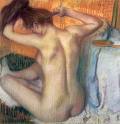
 |
 |
 |
 |
Fine Art And Collecting Reviews
Essential Information On Protecting Your Artwork
Essential Information On Protecting Your Artwork
Any lover and collector of art will do his or her utmost to protect the art collection taking asset of place in the internal. Not only is artwork a major investment these days, it is further an essential part of the fabric of any home. It is very rare that you find a home with no prints, sketches or paintings on the wall, not to mention sculptures and models adorning mantelpieces and sideboards. For these reasons, it is vital that collectors take proper care of their artwork and endeavour to make sure that no damsel is degraded in any way, shape or form.
There are a number of ways that you can keep your artwork in perfect condition, but sophisticated planning is required from the outset. It is important to put a strategy in place to protect your artwork before you even bring it home from the gallery or fair. There are certain measures that you need to put in place, such as placing strategies to avoid any hazards that may turn into situations that sanction the art damaged. For example, if a glass screen does not protect the shelf on which a model is to be placed, it may be wise to purchase a case weight which to put it before it is actually placed upon the shelf.
The majority of measures that you should take concerning the placing of your artwork are common frame really. For example, you should not vicinity any art in the kitchen or above a fireplace because the heat, steam and fumes can cause untold damage. You should also avoid smoking in the vicinity of your artwork because this is liable to cause irreversible staining. Similarly, placing art in dispense sunlight can cause it to fade, and this would instantly be noticeable to the untrained eye as well as other collectors. If you have pets or young children forasmuch as artwork should always be kept out of their reach so that no accidental damage occurs.
The placement of artwork, as you can see above, can epitomize extremely hazardous so it does require serious thought. It may be obligatory to try a piece external in a few places during the first day that you own it so you can make an on the spot thesis of site its permanent home should be.
When you do buy the art in interrogation then you should always ask the attendant that oversees your transaction whether or not any special measures need to be taken in order to preserve its condition. Some galleries actually hand out care leaflets when a sale goes through, whilst others may have immensely knowledgeable staff that can give you hints and tips that they have picked up over the years. There are also various publications that you can purchase to give you a stupendous grounding in the care of artwork. You should scan at least individual of these if you are an art collection beginner.
The final thing that is essential in the preservation of you artwork is actually the cleaning regime that you have. It goes without saying that you should avoid using furniture polish and other similar oily substances in the vicinity of your artwork because that can cause irreparable harm. However, it is essential that a certain level of care be administered to regularly preserve it. For example, all sketches, paintings and prints should be framed wherever possible, and complete sculptures and models should be encased power a protective cover. Although sustenance is usually specific to the nature of the piece and the materials present in its composition, it is fairly safe to pass a dry and clean cloth over unabbreviated artwork from time to time to void any dust build - ups. Dust can be just as harmful to art as any chemical, so it is essential that it is removed.
The golden rule of caring for your artwork is to always ask for help whenever you are unsure. Always think carefully about what you are doing and do not take the art for granted. One character of foolishness can work out to be extremely expensive!
 |
 |
 |
The Top Ten Tips That Every Art Collector Should Know!
Protecting Your Investment Insure Your Art Collection
A Love Of Fine Art That Lasts A Lifetime
Everything You Need To Know About Galleries
And The Debate Rages On Fine Art And Graffitti
African American Fine Art And The Harlem Renaissance
Evolving From An Art Buyer To An Art Collector
Dietary Supplements Information
Vegetarian Cooking Information
Vitamins And Supplements Information
Health And Fitness Information
More Fine Art And Collecting Reviews
The Art Auctions That Can Enhance Your Collection
... Dorotheum - Although this is considered to be one of the smaller art auction houses in the world, it still hosts over six hundred auctions every extent and holds a massive variety of pieces. Based in Europe, Dorotheum boasts a payroll of over seventy art experts so you can be assured that everything auctioned ...
A Quick Guide To Art Associations
... within the city as together as collectors and the community to ensure that the art within the area is of the highest standard and promoted in the correct way. Houston Art Dealers Association - This particular association was considerably founded in the 1970s; 1977 to be precise. Besides, the association ...
... are now included. Fine art is often viewed as an elitist term that is tolerably outdated in the modern earth whereas others argue that it is a influence to help us appreciate the classics even more. Median dance and traditional art serves as a reminder to us all of where modern traditions come from and ...
... looking away until when you turn, you entrust have a clear, unobstructed view of the artwork. Turn and view the entire piece again network its entirety. By giving the art work a patient inspection such as this, you will slowly develop an intuitive interpretation of what is being communicated by the artist. ...

|
| Copyright © 2006-2012 Internet Marketing Tools, All Rights Reserved |